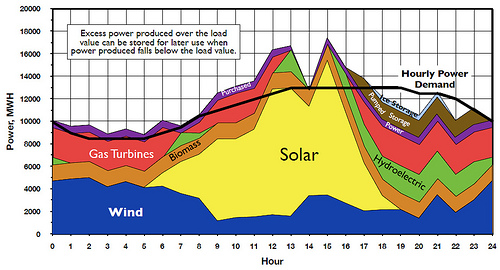Here's some hard evidence of FERC Chairman Jon Wellinghoff's assertion back in 2009 that baseload is outdated, we don't need any new nukes or coal, because we can get all the new power we need from sun and wind. This study from North Carolina goes further: we don't need coal or nukes at all.
John Blackburn, Ph.D. wrote a report March 2010, Matching Utility Loads with Solar and Wind Power in North Carolina: Dealing with Intermittent Electricity Sources,
Takoma Park, Maryland, and Durham, North Carolina, March 4, 2010: Solar and wind power can supply the vast majority of North Carolina's electricity needs, according to a major report released today. Combined with generation from hydroelectric and other renewable sources, such as landfill gas, only six percent of electricity would have to be purchased from outside the system or produced at conventional plants.
Hourly Power Generation and Load for a sample day in July
"Even though the wind does not blow nor the sun shine all the time, careful management, readily available storage and other renewable sources, can produce nearly all the electricity North Carolinians consume," explained Dr. John Blackburn, the study's author. Dr. Blackburn is Professor Emeritus of Economics and former Chancellor at Duke University.
"Critics of renewable power point out that solar and wind sources are intermittent," Dr. Blackburn continued. "The truth is that solar and wind are complementary in North Carolina. Wind speeds are usually higher at night than in the daytime. They also blow faster in winter than summer. Solar generation, on the other hand, takes place in the daytime. Sunlight is only half as strong in winter as in summertime. Drawing wind power from different areas — the coast, mountains, the sounds or the ocean — reduces variations in generation. Using wind and solar in tandem is even more reliable. Together, they can generate three-fourths of the state's electricity. When hydroelectric and other renewable sources are added, the gap to be filled is surprisingly small. Only six percent of North Carolina's electricity would have to come from conventional power plants or from other systems."
Six percent is a small number. That means most coal plants could be shut down, and no nukes are needed.
Continue reading